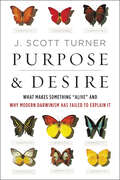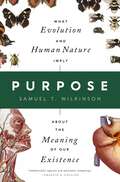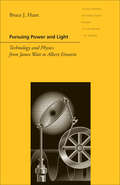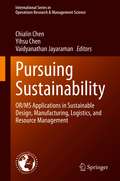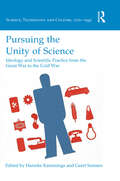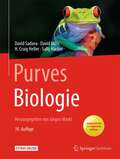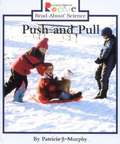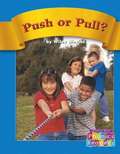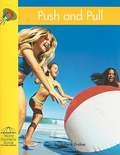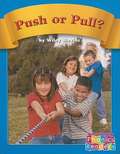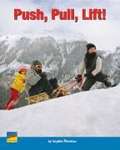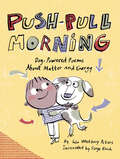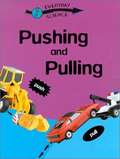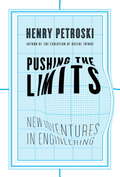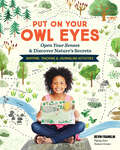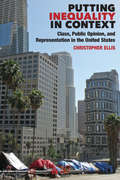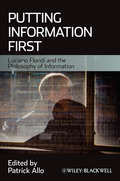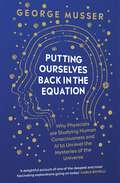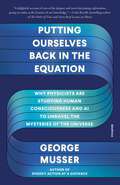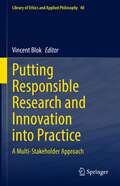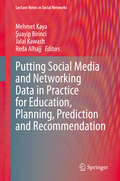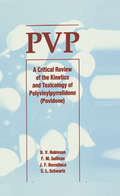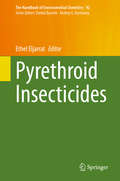- Table View
- List View
Purple Pinchers and Other Hermit Crabs (World Book's Animals of the World)
by Sheri RedaTopics in the book include how to care for a hermit crab, how it transfers from house to house, and how to care for one as a pet.
Purpose & Desire: What Makes Something "Alive" and Why Modern Darwinism Has Failed to Explain It
by J. Scott TurnerCan biology define life? “[An] ingenious mixture of science and philosophy. . . . highly thought-provoking.” —Kirkus Reviews (starred review)In this book a professor, biologist, and physiologist argues that modern Darwinism’s materialist and mechanistic biases have led to a scientific dead end, unable to define what life is—and only an openness to the qualities of purpose and desire will move the field forward.As Scott Turner contends: “To be scientists, we force ourselves into a Hobson’s choice on the matter: accept intentionality and purposefulness as real attributes of life, which disqualifies you as a scientist; or become a scientist and dismiss life’s distinctive quality from your thinking. I have come to believe that this choice actually stands in the way of our having a fully coherent theory of life.”Growing research shows that life’s most distinctive quality, shared by all living things, is purpose and desire: maintain homeostasis to sustain life. In Purpose and Desire, Turner draws on the work of Claude Bernard, a contemporary of Darwin revered among physiologists as the founder of experimental medicine, to build on Bernard’s “dangerous idea” of vitalism, which seeks to identify what makes “life” a unique phenomenon of nature. To further its quest to achieve a fuller understanding of life, Turner says, science must move beyond strictly accepted measures that consider only the mechanics of nature. A thoughtful appeal to widen our perspective of biology that is grounded in scientific evidence, Purpose and Desire helps us bridge the ideological evolutionary divide.“A must-read for everybody interested in the science of life and evolution . . . one of those rare science books which inquisitive laypeople will equally enjoy. Purpose and Desire will change the way you think of life.” —Washington Book Review“[A] beautifully written book, brimming with anecdotes and biological insights . . . will leave readers moved by Turner’s deep appreciation of life’s exquisiteness, its richness, and diversity . . . a provocative thesis, but one that is a wonderfully rich read, thought-provoking, and highly recommended.” —The Quarterly Review of Biology
Purpose: What Evolution and Human Nature Imply about the Meaning of Our Existence
by Samuel T. WilkinsonBy using principles from a variety of scientific disciplines, Yale Professor Samuel Wilkinson provides a framework for human evolution that reveals an overarching purpose to our existence. Generations have been taught that evolution implies there is no overarching purpose to our existence, that life has no fundamental meaning. We are merely the accumulation of tens of thousands of intricate molecular accidents. Some scientists take this logic one step further, suggesting that evolution is intrinsically atheistic and goes against the concept of God. But is this true? By integrating emerging principles from a variety of scientific disciplines—ranging from evolutionary biology to psychology—Yale Professor Samuel Wilkinson provides a framework of evolution that implies not only that there is an overarching purpose to our existence, but what this purpose is. With respect to our evolution, nature seems to have endowed us with competing dispositions, what Wilkinson calls the dual potential of human nature. We are pulled in different directions: selfishness and altruism, aggression and cooperation, lust and love. When we couple this with the observation that we possess a measure of free will, all this strongly implies there is a universal purpose to our existence. This purpose, at least one of them, is to choose between the good and evil impulses that nature has created within us. Our life is a test. This is a truth, as old as history it seems, that has been espoused by so many of the world&’s religions. From a certain framework, these aspects of human nature—including how evolution shaped us—are evidence for the existence of a God, not against it. Closely related to this is meaning. What is the meaning of life? Based on the scientific data, it would seem that one such meaning is to develop deep and abiding relationships. At least that is what most people report are the most meaningful aspects of their lives. This is a function of our evolution. It is how we were created.
Pursuing Power and Light: Technology and Physics from James Watt to Albert Einstein (Johns Hopkins Introductory Studies in the History of Science)
by Bruce J. HuntIn the nineteenth century, science and technology developed a close and continuing relationship. The most important advancements in physics—the science of energy and the theory of the electromagnetic field—were deeply rooted in the new technologies of the steam engine, the telegraph, and electric power and light. Bruce J. Hunt here explores how the leading technologies of the industrial age helped reshape modern physics.This period marked a watershed in how human beings exerted power over the world around them. Sweeping changes in manufacturing, transportation, and communications transformed the economy, society, and daily life in ways never before imagined. At the same time, physical scientists made great strides in the study of energy, atoms, and electromagnetism. Hunt shows how technology informed science and vice versa, examining the interaction between steam technology and the formulation of the laws of thermodynamics, for example, and that between telegraphy and the rise of electrical science.Hunt’s groundbreaking introduction to the history of physics points to the shift to atomic and quantum physics. It closes with a brief look at Albert Einstein’s work at the Swiss patent office and the part it played in his formulation of relativity theory. Hunt translates his often-demanding material into engaging and accessible language suitable for undergraduate students of the history of science and technology.
Pursuing Sustainability: OR/MS Applications in Sustainable Design, Manufacturing, Logistics, and Resource Management (International Series in Operations Research & Management Science #301)
by Vaidyanathan Jayaraman Yihsu Chen Chialin ChenThis handbook includes three parts, corresponding to the following three domains of OR/MS research related to sustainability: (i) Systems Design, Innovation, and Technology, (ii) Manufacturing, Logistics, and Transportation, and (iii) Sustainable Natural Resource Management. The first part of the handbook (Chapters 2-6) will focus on the creation and development of sustainable products, services, value chains, and organizations from a systems perspective. Key areas to be covered include Green Design & Innovation, Technology and Engineering Management, Sustainable Value Chain Systems, Sustainability Standards and Performance Evaluation, and Circular Economy and New Research Directions in Sustainability. The second part of the handbook (Chapters 7-11) will concentrate on the major operational and logistic issues faced by today’s industries in pursuing sustainability. Key areas to be covered include Remanufacturing, Reverse Logistics, Closed-Loop Supply Chains, Sustainable Transportation, and New Research Directions in Green Supply Chain Management. The third part of the proposed handbook (Chapters 12-16) will center on major sustainability issues in managing engineering infrastructure and natural resources. Key areas to be covered include Renewable Energy, Sustainable Water Resource, Biofuel Infrastructure, Natural Gas, and New Research Direction in Sustainable Resource Management.The handbook aims to bridge the three main OR/MS research domains in sustainability: “Systems Design, Innovation, and Technology,” “Manufacturing, Logistics, and Transportation,” and “Sustainable Natural Resource Management.” Traditionally, these domains are treated separately in the OR/MS literature. By combining the three domains, the handbook will provide a more holistic treatment of MS/OR methodologies to address critical sustainability issues faced by today’s society. Unlike most existing handbooks which only focus on current OR/MS research in sustainability within a domain, this handbook will include a concluding chapter in each of the three parts to discuss and identify potential future research directions in each of the three main domains.
Pursuing the Unity of Science: Ideology and Scientific Practice from the Great War to the Cold War (Science, Technology and Culture, 1700-1945)
by Harmke Kamminga Geert SomsenFrom 1918 to the late 1940s, a host of influential scientists and intellectuals in Europe and North America were engaged in a number of far-reaching unity of science projects. In this period of deep social and political divisions, scientists collaborated to unify sciences across disciplinary boundaries and to set up the international scientific community as a model for global political co-operation. They strove to align scientific and social objectives through rational planning and to promote unified science as the driving force of human civilization and progress. This volume explores the unity of science movement, providing a synthetic view of its pursuits and placing it in its historical context as a scientific and political force. Through a coherent set of original case studies looking at the significance of various projects and strategies of unification, the book highlights the great variety of manifestations of this endeavour. These range from unifying nuclear physics to the evolutionary synthesis, and from the democratization of scientific planning to the utopianism of H.G. Wells's world state. At the same time, the collection brings out the substantive links between these different pursuits, especially in the form of interconnected networks of unification and the alignment of objectives among them. Notably, it shows that opposition to fascism, using the instrument of unified science, became the most urgent common goal in the 1930s and 1940s. In addressing these issues, the book makes visible important historical developments, showing how scientists participated in, and actively helped to create, an interwar ideology of unification, and bringing to light the cultural and political significance of this enterprise.
Purves Biologie
by David Sadava H. Craig Heller David M. Hillis Sally D. HackerNeu im Purves: Evolution erheblich erweitertZoologie-Kapitel und -Glossar (neu!) durch Mitarbeit von Mary Berenbaum verbessertWeb-Links "Animated Tutorial" und "Web Activity" verweisen auf kostenfreie seite www.thelifewire.comAnzahl der Boxen "Experiment" sind deutlich erweitert Strukturierung erheblich verbessert durch Schlüsselsätze, Boxen zur "Wiederholung", "Kapitelüberblick" und "Kapitel-Zusammenfassung" sowie Fragen zur Selbstkontrolle70% neue Kapitel-Eröffnungenalle Texte von Biologie-Dozenten kritisch durchgesehen
Push And Pull
by Patricia J. MurphyThis Rookie Read-About Science book introduces kids to pushing and pulling. Colorful photos and simple text encourage children to read on their own as they learn about these forces and how they affect the movement of different objects.
Push Or Pull?
by Wiley BlevinsDiscusses forces such as push or pull in an easy-to-read text that incorporates phonics instruction and rebuses.
Push and Pull
by Hollie J. EndresYoung readers can find out more about how different objects can be pushed and pulled, and the scientific forces behind motion.
Push or Pull?
by Wiley BlevinsPhonics Readers is a recognized leader in helping you teach phonics and phonemic awareness, within the context of content-area reading. Content area focus: Pushes or Pulls Phonics Skills: long u (u_e, ew), inflectional ending -ed
Push, Pull, Lift!
by Vicki Rushworth David Haggerty Sophie PetratosIn this book, learn about simple machines and how people use them to push, pull, and lift.
Push-Pull Morning: Dog-Powered Poems About Matter and Energy
by Lisa Westberg PetersIntroduce children to physics through play, poetry, and a puppy in this joyous celebration of how physics matters in our everyday lives.This remarkable picture book explores scientific concepts (gravity, magnetism, electricity, friction, etc.) through the story of the relationship between a child and a puppy. Acclaimed author Lisa Westberg Peters&’s poems convey concepts in a way that children will remember—often with humor. Who could forget the various phases when they&’re presented in the form of a dog—solid when eating dinner, liquid when pouring herself into her basket, and gas when leaping erratically after a fly? Serge Bloch&’s whimsical illustrations extend the humor—and the love—in this tale of a child, a dog, and the energy that abounds in their world.Extensive notes at the end of the book define and explain the physics subjects included in the poems.
Pushing and Pulling
by Ray Moller Peter D. RileyPushing and Pulling introduces young readers to the fascinating world of cause and effect, as everyday objects like brushes, swings, and trains are pushed and pulled.
Pushing the Limits: New Adventures in Engineering
by Henry PetroskiHere are two dozen tales in the grand adventure of engineering from the Henry Petroski, who has been called America's poet laureate of technology. Pushing the Limits celebrates some of the largest things we have created-bridges, dams, buildings--and provides a startling new vision of engineering's past, its present, and its future. Along the way it highlights our greatest successes, like London's Tower Bridge; our most ambitious projects, like China's Three Gorges Dam; our most embarrassing moments, like the wobbly Millennium Bridge in London; and our greatest failures, like the collapse of the twin towers on September 11. Throughout, Petroski provides fascinating and provocative insights into the world of technology with his trademark erudition and enthusiasm for the subject.
Put On Your Owl Eyes: Open Your Senses & Discover Nature's Secrets; Mapping, Tracking & Journaling Activities
by Devin FranklinChildren will see the natural world around them with brand new eyes, as they learn to follow its signs, hear its language, and understand its secrets. With this unique and compelling book written by expert environmental educator Devin Franklin, kids aged 8 to 13 will build their own relationship with nature through finding a “Sit Spot” — an outdoor space in the backyard, in a field or in the woods, in a vacant lot or a city park — where they can stop, observe, and become familiar with the flora and fauna that live there. From the Six Arts of Tracking (Who, What, Where, When, Why, and How) and making a habitat map to walking in smooth silence like a fox and learning the basics of bird language, exploration exercises lead young readers on a fascinating journey of discovery as they watch, listen, map, interpret, and write about the sounds, sights, scents, and patterns they encounter. With journaling prompts, map-making activities, and observational tracking practice throughout, Put On Your Owl Eyes is an interactive and thought-provoking guidebook. This publication conforms to the EPUB Accessibility specification at WCAG 2.0 Level AA.
Putting Inequality in Context: Class, Public Opinion, and Representation in the United States
by Christopher EllisRising income inequality is highlighted as one of the largest challenges facing the United States, affecting civic participation and political representation. Although the wealthy often can and do exert more political influence, this is not always the case. To fix political inequality, it is important to understand exactly how class divisions manifest themselves in political outcomes, and what factors serve to enhance, or depress, inequalities in political voice. Christopher Ellis argues citizens’—and legislators’—views of class politics are driven by lived experience in particular communities. While some experience is formally political, on an informal basis citizens learn a great deal about their position in the broader socioeconomic spectrum and the social norms governing how class intersects with day-to-day life. These factors are important for policymakers, since most legislators do not represent “the public” at large, but specific constituencies. Focusing on U.S. congressional districts as the contextual unit of interest, Ellis argues individuals’ political behavior cannot be separated from their environment, and shows how income’s role in political processes is affected by the contexts in which citizens and legislators interact. Political inequality exists in the aggregate, but it does not exist everywhere. It is, rather, a function of specific arrangements that depress the political influence of the poor. Identifying and understanding these factors is a crucial step in thinking about what reforms might be especially helpful in enhancing equality of political voice.
Putting Information First: Luciano Floridi and the Philosophy of Information (Metaphilosophy Ser. #16)
by Patrick AlloPutting Information First focuses on Luciano Floridi’s contributions to the philosophy of information. Respected scholars stimulate the debate on the most distinctive and controversial views he defended, and present the philosophy of information as a specific way of doing philosophy. Contains eight essays by leading scholars, a reply by Luciano Floridi, and an epilogue by Terrell W. Bynum Explains the importance of philosophy of information as a specific way of doing philosophy Focuses directly on the work of Luciano Floridi in the area of philosophy of information, but also connects to contemporary concerns in philosophy more generally Illustrates several debates that arise from core themes in the philosophy of information
Putting Ourselves Back in the Equation: Why Physicists Are Studying Human Consciousness and AI to Unravel the Mysteries of the Universe
by George MusserDistant galaxies, dark matter, black holes – elusive, incomprehensible and inhospitable – these are the building blocks of modern physics. But where do we fit in this picture? For centuries, we have separated mind from matter. While physicists have pursued a theory of &‘everything&’ with single-minded purpose, the matter of the mind, of human consciousness, has been conveniently sidestepped and ignored – consigned to priests, philosophers and poets. With the ambition of Stephen Hawking, Carlo Rovelli and Brian Cox, Putting Ourselves Back in the Equation sets out a bold new vision for theoretical physics, unrestricted by sleek equations and neat formulations. Combining cutting-edge neuroscience with the latest in quantum mechanics, acclaimed writer Musser offers a new interpretation of human consciousness. From bizarre cognitive phenomena, like lucid dreaming and self-taught synaesthesia, to the latest technological developments in AI, Musser asks: what can physics teach us about what it means to be human?
Putting Ourselves Back in the Equation: Why Physicists Are Studying Human Consciousness and AI to Unravel the Mysteries of the Universe
by George Musser“This is a delightful account of one of the deepest and most fascinating explorations going on today at the frontier of our knowledge.” —Carlo Rovelli, bestselling author of The Order of Time and Seven Brief Lessons on Physics“Musser knows that the point of popular science is [. . .] to get a sense of what’s at stake, what kinds of answers are being offered to difficult questions, and why it all matters. One could not ask more of Putting Ourselves Back in the Equation—on all three counts it delivers.” —Julian Baggini, The Wall Street JournalA revelatory exploration of how a “theory of everything” depends upon our understanding of the human mind.The whole goal of physics is to explain what we observe. For centuries, physicists believed that observations yielded faithful representations of what is out there. But when they began to study the subatomic realm, they found that observation often interferes with what is being observed—that the act of seeing changes what we see. The same is true of cosmology: our view of the universe is inevitably distorted by observation bias. And so whether they’re studying subatomic particles or galaxies, physicists must first explain consciousness—and for that they must turn to neuroscientists and philosophers of mind.Neuroscientists have painstakingly built up an understanding of the structure of the brain. Could this help physicists understand the levels of self-organization they observe in other systems? These same physicists, meanwhile, are trying to explain how particles organize themselves into the objects around us. Could their discoveries help explain how neurons produce our conscious experience?Exploring these questions and more, George Musser tackles the extraordinary interconnections between quantum mechanics, cosmology, human consciousness, and artificial intelligence. Combining vivid descriptive writing with portraits of scientists working on the cutting edge, Putting Ourselves Back in the Equation shows how theories of everything depend on theories of mind—and how they might be one and the same.
Putting Pharmacokinetics and Pharmacodynamics to Work in Drug Discovery: A Practical Guide for Pharmaceutical Scientists
by Emile P. ChenDevelop drugs with a greater understanding of their bodily impact Pharmaceutical scientists in the fields of pharmacokinetics and pharmacodynamics study how drugs behave in the body and how they reach their site of action to exert their intended pharmacological activities. Drug discovery stands to benefit enormously from the timely application of pharmacokinetics and pharmacodynamics in order to make informed decisions and solve practical problems. Putting Pharmacokinetics and Pharmacodynamics to Work in Drug Discovery bridge between scientific concepts and practical industrial practice by bringing these principles to bear on every stage of the drug discovery process. Beginning with target identification and moving through each subsequent decision point including high throughput screening, hit-to-lead, lead optimization and candidate selection. The book offers a comprehensive guide to minimizing attrition, reducing costs, and more. The result is an invaluable tool in developing smarter and more effective drug discovery processes. Putting Pharmacokinetics and Pharmacodynamics to Work in Drug Discovery readers will also find: A work designed to make scientific principles accessible to pharmaceutical scientists in diverse areas, not just pharmacokinetists or DMPK scientists Industrial examples, both positive and negative, showing pharmacokinetic and pharmacodynamic principles at work Interactive exercises at the end of each section to encourage holistic and integrated thinking Putting Pharmacokinetics and Pharmacodynamics to Work in Drug Discovery is ideal for any researchers or professionals involved in drug discovery and development, including medicinal chemists, biopharmaceutics scientists, clinicians, project leaders, and many others.
Putting Responsible Research and Innovation into Practice: A Multi-Stakeholder Approach (Library of Ethics and Applied Philosophy #40)
by Vincent BlokThis Open Access book builds on the experiences of one of the largest European projects in the domain of responsible Research and Innovation: NewHoRRIzon. It highlights the potential of and opportunity in responsible R&I to conduct innovation in a socially responsible way. Employing the methodology of Social Labs, the book analyses responsible R&I from an experience-based viewpoint and further explores the application of responsible R&I beyond scholarly and industrial interests. The contributors analyze the current European R&I landscape, provide reflection and reconceptualization of its core concepts, and project future challenges in relation to responsible R&I. The book complements the readers' line of work by providing insights on how responsible R&I can be applied by the audience, for example, in their decision-making processes.
Putting Social Media and Networking Data in Practice for Education, Planning, Prediction and Recommendation (Lecture Notes in Social Networks)
by Jalal Kawash Reda Alhajj Mehmet Kaya Şuayip BirinciThis book focusses on recommendation, behavior, and anomaly, among of social media analysis. First, recommendation is vital for a variety of applications to narrow down the search space and to better guide people towards educated and personalized alternatives. In this context, the book covers supporting students, food venue, friend and paper recommendation to demonstrate the power of social media data analysis. Secondly, this book treats behavior analysis and understanding as important for a variety of applications, including inspiring behavior from discussion platforms, determining user choices, detecting following patterns, crowd behavior modeling for emergency evacuation, tracking community structure, etc. Third, fraud and anomaly detection have been well tackled based on social media analysis. This has is illustrated in this book by identifying anomalous nodes in a network, chasing undetected fraud processes, discovering hidden knowledge, detecting clickbait, etc. With this wide coverage, the book forms a good source for practitioners and researchers, including instructors and students.
Pvp: A Critical Review of the Kinetics and Toxicology of Polyvinylpyrrolidone (Povidone)
by Wolfgang SchwarzPolyvinylpyrrolidone is widely used in medicine, pharmaceuticals, cosmetics, foods, printing inks, textiles, and many more diverse applications. This book describes the 50 years of research, published and unpublished, on the absorption, distribution, storage, and excretion of PVP. The toxicology of PVP is critically evaluated. The author's involvement in the recent reevaluation of PVP by the Joint Expert Committee on Food Additives of the World Health Organization (WHO) and the Food and Agriculture Organization (FOA) led them to undertake this comprehensive review of all the information on the subject. This book will be invaluable for anyone who is involved with polyvinylpyrrolidone. Included is a broad review of the toxicological studies performed on PVP, including acute, subchronic, chronic, reproductive, mutagenicity, and carcinogenicity studies. There is also an appendix listing the key studies, with references, on the absorption, renal elimination, distribution, acute toxicity, subchronic toxicity, chronic toxicity, teratogenicity, mutagenicity, and carcinogenicity of PVP.
Pyrethroid Insecticides (The Handbook of Environmental Chemistry #92)
by Ethel EljarratThis book reviews the latest developments concerning the analysis, fate, behaviour and toxicity of pyrethroid insecticides. Over the last few decades, pyrethroid insecticides have increasingly replaced organochlorine pesticides due to their relatively lower mammalian toxicity, selective insecticide activity and lower environmental persistence. They represent 25% of global sales of insecticides, and are considered to be “safe” since they are converted to non-toxic metabolites by oxidative metabolism in fish and by hydrolysis in mammals. However, recent studies have demonstrated their environmental ubiquity, their bioaccumulation and their toxicity in various aquatic and terrestrial organisms, and even in humans. Featuring contributions by leading experts, the book discusses the physico-chemical properties and uses of pyrethroid insecticides; the latest chemical analytical methods; their occurrence in the environment, biota and food; and their isomeric and enantiomeric behaviour. It particularly highlights the toxicological effects and human exposure to pyrethroid insecticides, and also offers insights into the effects of the salmon industry on the marine environment with a case study of sea lice treatment using pyrethroids. This comprehensive book is a valuable source of information for environmental scientists, policymakers and producers interested in issues related to pyrethroid insecticides.

